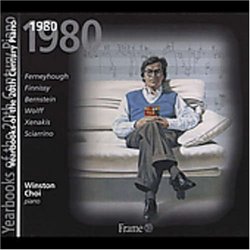| All Artists: Brian Ferneyhough, Michael Finnissy, Leonard Bernstein, Christian Wolff, Iannis Xenakis, Salvatore Sciarrino, Winston Choi Title: Yearbooks of the 20th Century Piano: 1980 Members Wishing: 0 Total Copies: 0 Label: Frame Release Date: 3/29/2005 Genre: Classical Styles: Chamber Music, Forms & Genres, Short Forms, Historical Periods, Classical (c.1770-1830), Modern, 20th, & 21st Century, Instruments, Keyboard Number of Discs: 1 SwapaCD Credits: 1 UPCs: 8018159034526, 818159034520 |
Search - Brian Ferneyhough, Michael Finnissy, Leonard Bernstein :: Yearbooks of the 20th Century Piano: 1980
 | Brian Ferneyhough, Michael Finnissy, Leonard Bernstein Yearbooks of the 20th Century Piano: 1980 Genre: Classical
|
Larger Image |
CD Details |
CD ReviewsMostly great exciting playing, some lows however scarecrow | Chicago, Illinois United States | 06/23/2005 (4 out of 5 stars) "The Ferneyhough piece here:Lemmi-Icon-Epigram: has become part of modern repertoire. Damierini its dedicatee who learned it in a month for the Venice Biennale has good things about it, more impassioned than Ian Pace,making the work's expressive extremities be felt a little more. Pace seems to be like Arditti, he "Pace-ifies" everything he plays, this usually means exploiting a center,safe expressive interpretive realm, nothing too exciting(as in his Finnissy :Gershwin Arrangements:,lowly dull and unispired as opposed to the more upbeat Nic Hodges). Like Arditti, who play such an enormous repertoire it is hard to distiguish one piece from the next, it all seems to have the same identical blends and timbres, Pace as well has an enormous repertoire, well both shall we say "Arditti-ize all they play never really searching for an expressive center, well sometimes as in Nono,they make more noises say than the LaSalle Quartet. Choi doesn't have these excessive problems and hones each piece he plays(save the Wolff for later) here simply excites the pages of the Ferneyhough,finding an expressive center that roles off the page quite well, whereas Pace's reading seems timid and lumbered,cumbersome,Choi also exploits the works expressionist ideology bringing an impeccable sense of timbre, a student of Ursula Oppens, you can sense the impassioned-ness.
Christian Wolff's "preludes" are another matter. Here he(Wolff) gives much Cage-ian freedoms, no dynamics are given, no articulations, tempi are never given but once you adopt one, choose one, you must stick to it for a time until an indication (two slanted lines)is represented to change it as in the "toccata" like prelude #1, Choi seems to think all you need to do is play the right notes and the piece will somehow be convincing and exciting, No, not here, please recall the Sally Pinkus recording,where there she brings incredible gesturing insight, a unrelenting momentums and shaped phrases that make one listen. Choiseems to step back from this, but he should have listened to that, the Pinkus to get a point of reference and where he could have bought other dimensions, expressive and intepretively to these rather unfinished Ives-ian preludes."Prelude" #3 is more like a funeral dirge.Many times there is so much transformations of materials, changes that these preludes become like tone poems of the Left. Wolff interjects old Wobbly IWW tunes within the welter and texture of the proceeding here, and again the committment is a difficult one. Wolff greatest achievement in maintaining modernist freedoms is that you can spend much time playing these works, put them away and play them again entirely differently. Finnissy's "Reels" has a great conception at work here primarily ornamental like materials as most of his works, exploiting a high virtuosity of gesture, a density, here in "reels" focused almost exclusively in the treble range and registers, traditionally beautiful,yet continuously texture bound,they do alternate between more regular dance like ones and rhythmically freer ones,this to give some shape, more simply mists, wists of timbre.Choi does good here as well.Clean transparent playing, not demanding another voice to interpret deeply as in the Wolff,For Xenakis you simply again cannot play the right notes and leave it there for posterity; you have to render that "end-of-the-world, (really end of modernity) dimension, like things are coming apart at the seams, "mists" is a more predictable work than the earlier "Herma" or ;evyrali; from 1973."Mists" begins always in the lower basso regions of the piano and works its way upwards,accreting adding notes and densities as one progresses.Xenakis would array/align these motions on graphs and charts prior to assignments of tones on traditional system staff music paper. So you sense this for all tones do not lay neatly for the fingers. Bernstein was a marvelous pianist himself I would have loved to hear him simply improvise a tune,here"touches" reveals this freedom and reveals further that Lenny should have written more for solo piano,at times the composition is tenuous like he doesn't know where to go next,like his career itself, well we cannot do it all. Sciarrino has also written some fascinating piano music from the perspective of post-modern expression like picking up the "crumbs" from the grand orgy that was modernity. all his piano music is technically bound to virtuosity, fast filigree,presto presstissimo toccata like gestures seem to be always the center content, (The Five Piano Sonatas are great exmples of this oeuvre) Here the Anamorfosi we find a relatively lighthearted Sciarrino, playinf materials backwards." |

 Track Listings (21) - Disc #1
Track Listings (21) - Disc #1